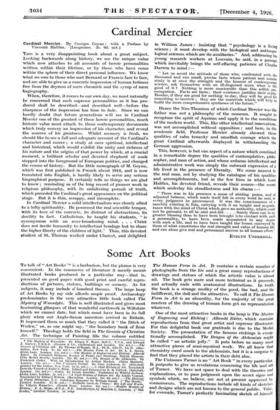Some Art Books
To talk of " Art Books"* is a barbarism, but the phrase is very convenient. In the commerce of literature it merely means illustrated books produced in a particular way—that is, presented on good paper with good print and careful repro- - ductions of pictures, statues, buildings or scenery. As for subjects, it may include if hundred themes. The large heap of Art Books by my side affords ample proof. Archaeology predominates in the very attractive little book called The Mystery of Wansdyke. This is well illustrated and gives most fascinating glimpses of that wonderful earthwork in Wiltshire which we cannot date, but which must have been in its full glory when our Anglo-Saxon ancestors arrived in Britain. It impressed them so much that they called it " the Ditch of Woden," or, as one might say, " the boundary bank of Zeus himself." Theology holds the field in The Genesis of Christian Art. The technique of Painting fills the volume entitled
• The Mystery of Waradyke. By Albany F. Major, Oill.E., F.S.A., and Edward 1. Burrow, F.R.G.S. (Burrow & Co., Cheltenham and London. 25e. net.)—The Genesis of Christian Art. By Thomas °Mogan, M.A., Ph.D., Litt.D., LL.D. (Mac- millan, New York. 6s. 6d. net.)—The Human Form in Art. By A. A. Braun. (John Lane, London. 15e. net.)—The Masters of Engraving and Etching: Albrecht .Ddrer. By Campbell Dodgson, Keeper of Prints and Drawinp, British Museum. (The Medici Society. London. 22s. 6d. net.)—The Dragon of the Alchemists. By Frederick Carter. With au Introduction by Arthur Machen. (Elkin Mathews, London. 21s. net..)--The Unknown Turner. By John Anderson, Jr. (Privately printed for the Author, New York. £3 as. net.)—A Short History of Art. Translated from the French of Andre S. Blum. Edited and Enlarged by R. R. Tatiock. (Botsford, London. 21s. net.)--Rodin. By Lennie Ben&llte. Translated by Wilfrid Jackson. (John Lane. London. as. net.)—A Short History of Italian Art. By Adolfo Venturi. Translated by Edward Hutton. (Macmillan. London. 10s. 6d. net.)—The Etchings. of Frank Branguyn, R.A. Catalogue Itaisonne: by William Gaunt. C' The Studio.' Limited London. £2 b. net.)---Raffaello Sonti cia Urbino: Ilia Life.rind ;roan. By Vilhelm Wanscher. (Ernest Bean. London. 30s. net.)—Modern Masters of Etching ; C. it. IOWANS, A..R.A., R.E. Introduction by Malcolm G. Batsman. (" The Studio," Litulted:-Londou. 5e: net.1" The Human Form in Art. It contains a certain number of photographs from the life and a great many reproductions of drawings and statues of which the artistic value is almost nil. The book gets more and more technical as it proceeds, and actually ends with anatomical illustrations. In truth, the book is a strange medley of the good, the bad, and the indifferent, the dull and the attractive. To call it The Human Form in Art is an absurdity, for the majority of the great masters of the drawing of human form get no representation whatever.
One of the most attractive books in the heap is The Masters of Engraving and Etching : Albrecht Diiier, which contains reproductions from that great artist and supreme illustrator. For this delightful book our gratitude is due to the Medici Society. The presentation of the famous etchings is excep- tionally accomplished. The Dragon of the Alchemists might be called " an artistic jolly." It puts before us many most attractive pieces of semi-mystical work. We all knew that chemistry owed much to the alchemists, but it is a surprise to find that they placed the artists in their debt also.
The Unknown Turner is an " Art Book " in every particular. It purports to give us revelations concerning the life and ad of Turner. We have not space to deal with the theories and explanations, or to pass judgment upon the secret signs and symbols which, we believe, are not at present approved by connoisseurs. The reproductions include all kinds of sketches and designs which are not known to the general public. Take, for- example, Turner's perfectly faicinatini sketch of himself in 1833, taken from the Diary of a Foreign Tour and pro- duced here for the first time. In it the painter portrays himself painting with sketch-book on his knee, spectacles on nose, and embellished with a tall hat and black cravat. It is a priceless contribution to our knowledge of the artist. There is g fascinating representation of Turner's map-making tour of 1839. It deals with the Lakes of Zug and Lucerne and the country between them. Finally, we actually have a drawing Girlie Grand Opera House in Paris in 1833, a most careful and elegant piece of draughtsmanship. A Short History of Art rightly holds a place, but, in spite of excellent architec- tural drawings and reproductions of statuary and pictures, it cannot claim to be more than an efficient handbook. The field is so vast and the space so limited that one cannot help feeling admiration for the courage of the Editor.
The justification of the presence of the little book, Rodin, is the fact that it gives us a large number of well-presented re- productions of Rodin's chief works. A Short History of Italian Art is a translation of a book held in Italy to be a
standard work. The etchings of Mr. Brangwyn are reproduced for English readers, with a translation of the works of a
French critic in The Etchings of Frank Brangwyn, R.A.
Another book of etchings in the Studio's series of Modern Masters of Etching, with an Introduction by Mr. Malcolm
C. Salaman, shows us examples of the work of that admirable illustrator, black-and-white draughtsman and etcher, Mr. Frederick Griggs. It is impossible here to do justice to the exquisite character of the plates. Raffaello Santi Da Urbino : his Life and Works, deserves high praise for the beauty of the printing and of the reproductions of the pictures and draw- ings. To attempt criticism of the letterpress in the space of this notice is impossible.































































 Previous page
Previous page